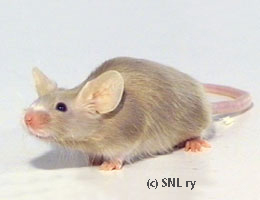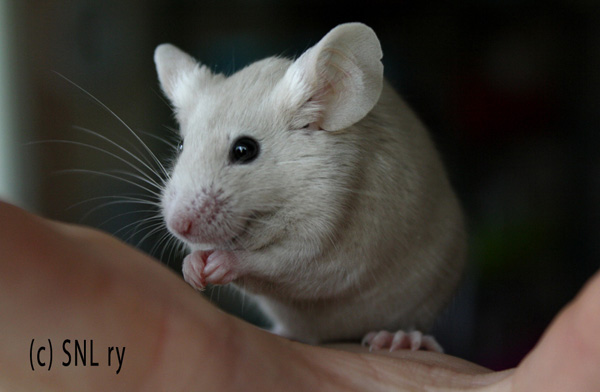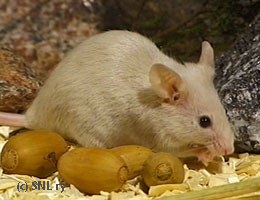Varieties
I - Self
Beige (be)
a/a B/* D/* ce/ce
"The colour should be a clear, greyish shade of beige, not too dark. Eyes black."
Breeding information below the pictures.
Quick Look
Beige was for a long time considered an unwanted, but unavoidable side-product of breeding bones (in most mouse standards, bone is called cream). Not being standardised and coming in quite a number of shades, the variety wasn't considered useful for much more than making all-bone litters when crossed with a pink eyed white.
Beige was first standardised in USA, where one shade was picked as the one to breed for. Later on, the Finnish Show and Pet Mouse club followed the example of the American clubs and standardised beige - through the normal route of the new variety starting out as an unstandardised variety and going through provisional standards before gaining full standard status.
As noted above, beiges come in quite a variety of shades, so careful selective breeding is required to get the right shade in. Beiges also tend to darken with age, as do basically all c-locus recessive colours (except for, of course, the albino pink eEyed white).
Many American and Australian standards have another variety with (basically) the same genotype standardized, under the name coffee. This is a darker version of the same theme, resembling the colour of cafe au lait. In Finland, coffee is an unstandardised variety.
Genetic Background
Genetically speaking, beige is a black mouse with two extreme dilution genes: a/a B/* D/* ce/ ce P/*, with the correct shade determined by a correct set of modifiers. It is also quite possible to get nice looking beiges with a/a b/b D/* ce/ ce P/* - that is, on a brown background. These, however, have slightly off-black eye colour, by which they can be told apart from "black background" beige mice.
As an a/a b/b mouse has less intense pigmentation than B/* (being a light, milky chocolate), you would expect this difference to show in beige mice. The genetic explanation for the similarity of black- and brown-background beiges is that as the c-locus recessives affect brown pigment less than black pigment, the shade difference between B/* and b/b evens out.
Taken into consideration the deliciously deep chocolate colouring demanded in the chocolate standards, it wouldn't be far-fetched to claim that on a chocolate background (a/a bc/* D/* ce/ ce P/* ) the mouse would be darker in colour, i.e. coffee
The official name of the gene (in genetic parlance allele) that makes a mouse beige instead of Black is extreme dilution and it is a spontaneous recessive mutation of tyrosinase. The official geneticist's symbol is Tyrc-e. It is located in chromosome 7.
The colour of the mouse is changed from black to beige because the extreme dilution gene restricts the formation of melanine on the mouse's hair.
In More Practical Terms...
Beige is best mated with another beige, paying attention to the correct shade. It may be a good idea to keep at hand a few too light and too dark beiges, in order to nudge the shade back into correct direction if needed. Some beige breeders have noted that outcrossing to a (light) bone can help, if the colour is getting too dark.
If you must do an outcross to a C/* mouse, use black, not even thinking about chocolate, blue, or the rest of the bunch. However, be aware that C/* outcrosses can bring in other c-locus recessives, causing quite a headache for the poor breeder - especially chinchilla (cch). Needless to say, if your goal is to breed beige, it's better not to mix in any of the chinchilla-gened varieties at all.
As beige is a self variety, it is best to keep all agouti varieties off of the line. Mixing in A/* varieties would give you "beige agoutis", where the black portion of the agouti's coat is diluted to beige, the golden brown to almost white. The first description of an extreme dilution mouse (wild mouse caught in a corn crib in Illinois, in 1921) is rather fitting, taking into consideration the difference between a wild agouti coloured mouse and a Fancy mouse: "a slightly stained or dirty black-eyed white".
Varieties with the lethal yellow Ay (red, fawn, sables) are quite unsuitable for beige breeding. Extreme dilution "wipes out" all red pigment quite effectively, so mixing in this dominant gene would give you obese black eyed whites along the line. It's also possible to end up with "beige sable", which is basically a fat white mouse with very faint beige shading.
What about tans, then? Well, using tans will give you beige Fox, an altogether different variety. (With chocolate tans, you'd quite likely get coffee fox later in the line.)
Starting From Scratch?
If there are no beiges to start with, try to find bones. Bone x bone mating gives you pink eyed white, bone and the beige. Another option is to get a couple of colorpoint beiges. These mated together give siamese and beige. Rather than making these combinations yourself, you might want to try asking bone and colorpoint beige breeders for available beige mice to begin with, or if you can place a reservation for one. Both bone and colorpoint beige breeders get beiges in their litters.



